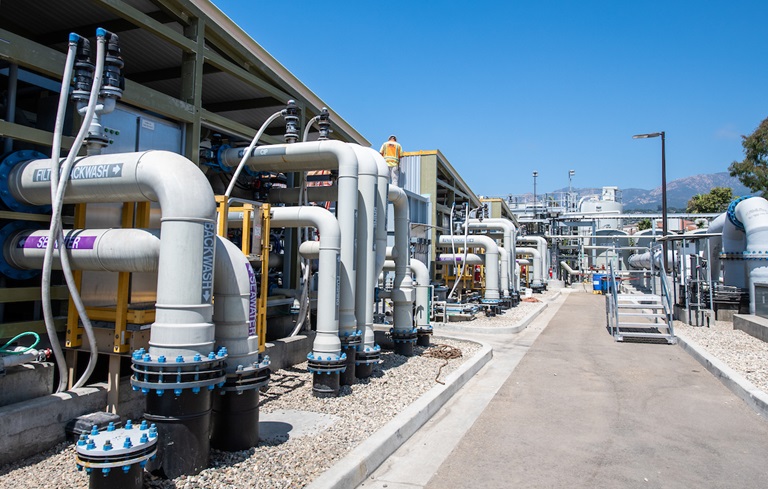DWR Contributes $16 Million to Support Desalination Research, Improved Energy Efficiency
Image of Charles E. Meyer Desalination Plant in Santa Barbara, which plays a key role in improving water reliability and resiliency for the city during the drought years. Photo taken August 28, 2019. 
California is facing the real-time impacts of a changing climate evident by our state’s historic drought. With limited water supplies, California must look to innovative technologies to meet the demands of the state’s growing population. One potential solution is desalination, the method of treating seawater and other salty waters to be suitable for consumption or irrigation.
In an effort to move the research forward and secure a more resilient water supply in the future, DWR has contributed $16 million to the National Alliance for Water Innovation (NAWI) in support of advancing desalination research.
Led by the Lawrence Berkeley National Laboratory, NAWI is a research association selected by the U.S. Department of Energy (DOE) to serve as the Energy-Water Desalination Hub coordinator for a five-year project dedicated to early-stage desalination research. DOE awarded the project a $100 million grant.
The program includes more than 180 institutions – including DWR – working toward a goal of water resilience through the development of technologies that treat seawater, brackish water, and tainted groundwaterfor use in municipal, industrial, agricultural, utility, oil and gas, and other water supply needs.
“ Regardless of whether next year is wet or dry, a diverse water supply portfolio can help meet California's existing and future water supply and environmental needs. By investing in this research, DWR strives to move that goal forward,” said Kris Tjernell, DWR deputy director of Integrated Watershed Management.
DWR’s contribution will help fund research necessary for operational improvements of existing desalination technologies implemented in California. Where possible, the program will involve existing grantees of DWR’s Water Desalination Grant Program.
Desalination is the process of removing salts and minerals from saline water (brackish water and seawater as well as municipal and industrial wastewater) to produce water suitable for consumption, irrigation, and other water supply needs. Although effective, the main drawbacks of desalination are cost and energy requirements, environmental impacts associated with water intake, and brine management.
NAWI and their team of institutions will conduct research to lower the cost and energy of desalination, improve brine management, increase longevity of system components, and develop methods to optimize operational efficiency. It is hoped that the benefits realized in the desalination industry will support other industrial sectors.
Working with NAWI, DWR will review, select, and fund research projects that focus on energy reductions or cost savings for desalination projects.
“DWR’s investment in this groundbreaking technology program brings us more than simply additional resources – DWR brings their keen insights into California’s current and future water challenges, and clarity on which research investments have the greatest potential to move the needle on California’s water supply in the future. We hope this is just the beginning of a lasting partnership between the DWR and the DOE,” said NAWI Executive Director, Peter Fiske.
In addition to energy efficiency, NAWI is seeking to address other key water supply issues impacting California including brine management, low-cost, independent treatment unit development, and oil field (produced) water treatment. For more information about NAWI and their mission, visit www.nawihub.org
